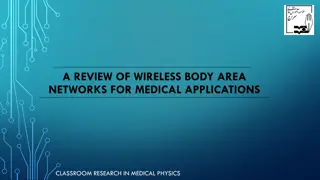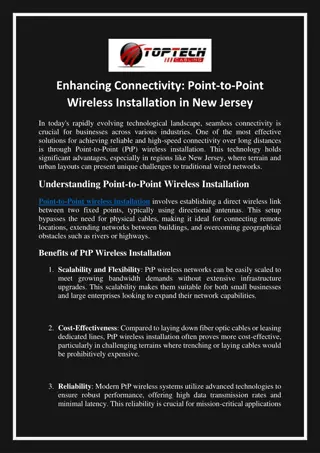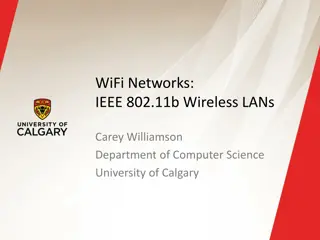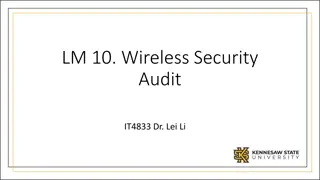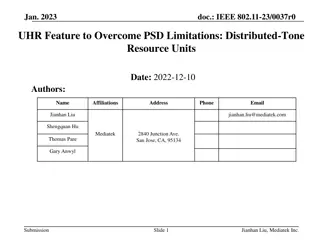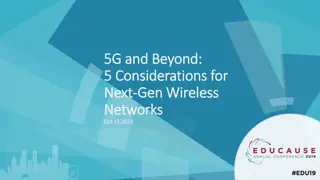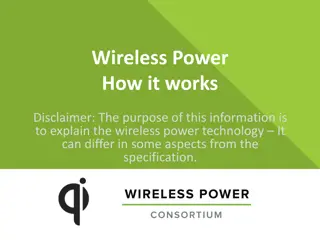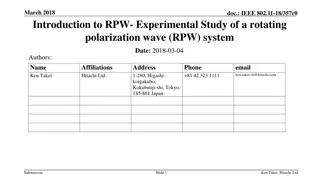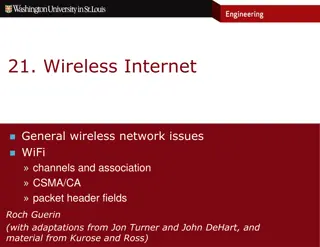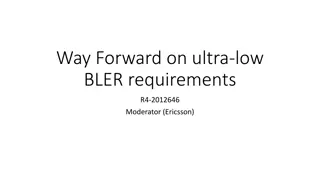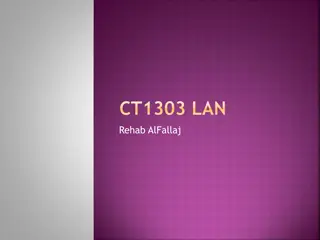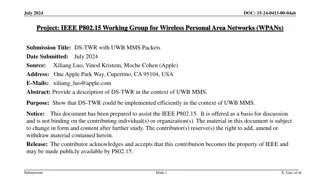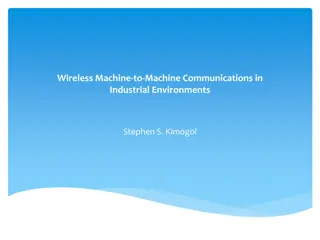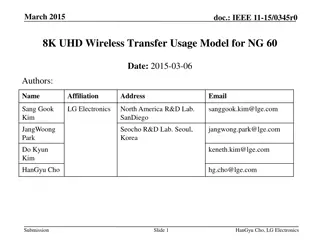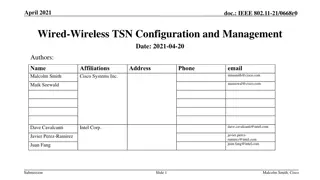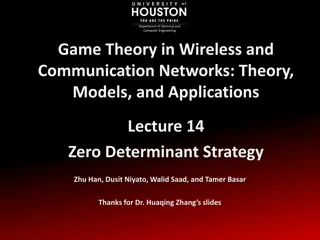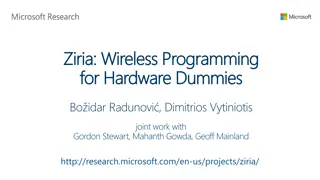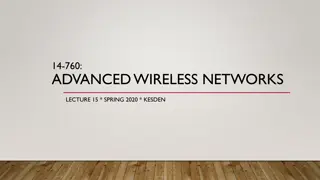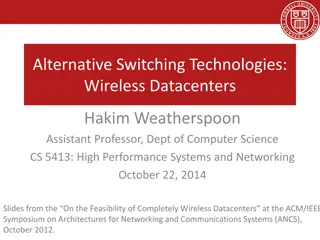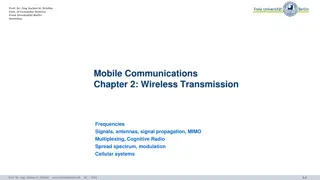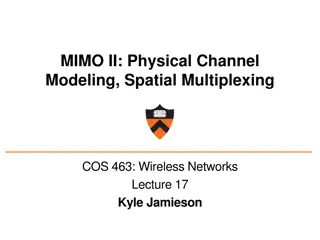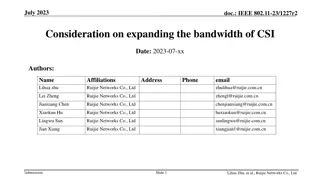Enhance Your Wireless Range: 192.168.188.1 Wireless Extender Setup with Top Apps
Are you tired of weak Wi-Fi signals limiting your internet access? Fear not! With the 192.168.188.1 Wireless Extender Setup and some top-notch apps, you can extend your wireless range and enjoy seamless connectivity throughout your home or office.\n\nfor more info: https:\/\/1921681881.com\/192-168-
6 views • 2 slides
Scrolls:Rolling Flexible Surfaces for Wideband Wireless
Revolutionizing wireless communication, the Scrolls project introduces rolling flexible surfaces for wideband wireless applications. With the expectation of 30 billion wireless devices by 2025, the project emphasizes standards and frequencies such as Cellular, Wi-Fi, and IoT. By offering a standard-
2 views • 19 slides
Understanding Wireless Communication Networks by Dr. K. Gopi at SITAMS
Wireless Communication Networks (WCN) is a fundamental aspect of modern telecommunication, allowing information transfer without physical connections. Dr. K. Gopi, an Associate Professor at the Department of ECE at SITAMS, introduces concepts like multiple access techniques, traffic routing, and the
1 views • 13 slides
Evolution of Wireless-Wireline Convergence in 5G Networks
The convergence of wireless and wireline networks in the context of 5G brings about significant changes and improvements. This evolution involves the integration of 5G core networks, new access network functions, enhanced interfaces, and the introduction of new devices like 5G residential gateways.
7 views • 25 slides
Long-Range Wireless Charging Market Report & Analysis _ BIS Research [2024-2035]
The Long-Range Wireless Charging Market has experienced robust expansion, fueled by the proliferation of smart devices and the increasing adoption of electric vehicles (EVs). According to recent studies, the global long-range wireless charging market is estimated to reach $3,279.6 million by 2035, a
1 views • 3 slides
A Review of Wireless Body Area Networks for Medical Applications
Recent advancements in MEMS technology, integrated circuits, and wireless communication have enabled the development of Wireless Body Area Networks (WBANs) for ambulatory health monitoring. This paper discusses the infrastructure, in-body antenna design, low-power MAC protocol, and various applicati
1 views • 23 slides
Enhancing Connectivity - Point-to-Point Wireless Installation in New Jersey
Point-to-Point wireless installation involves establishing a direct wireless link between two fixed points, typically using directional antennas. This setup bypasses the need for physical cables, making it ideal for connecting remote locations, exten
2 views • 2 slides
Effective Communication Skills for Healthcare Professionals
Enhance your communication skills with the Accelerated Preceptorship Communication Session by Desiree Cox. Learn the importance of effective communication, different communication preferences, communication dynamics, non-verbal communication, listening skills, and more. Understand the communication
2 views • 28 slides
Understanding Different Types of Wireless Transmission Media
Wireless transmission encompasses various forms of unguided media, including radio, microwave, and infrared waves. Each type serves unique communication purposes based on their frequency ranges, wavelengths, and propagation characteristics. Wireless signals, whether through radio waves with extensiv
0 views • 6 slides
Rate Optimization in Wideband RIS-assisted Wireless Systems
This research focuses on rate optimization in wideband RIS-assisted wireless systems, specifically investigating MIMO RIS-assisted systems in sub-6 GHz mmWave settings. Pathloss and blockage modeling, along with LOS vs. spectral efficiency and RIS-UE distance vs. spectral efficiency analyses, are ke
0 views • 4 slides
Understanding Wireless Wide Area Networks (WWAN) and Cellular Network Principles
Wireless Wide Area Networks (WWAN) utilize cellular network technology like GSM to facilitate seamless communication for mobile users by creating cells in a geographic service area. Cellular networks are structured with backbone networks, base stations, and mobile stations, allowing for growth and c
2 views • 17 slides
Understanding IEEE 802.11b Wireless LANs
IEEE 802.11b wireless LAN standard shares similarities with Ethernet LANs but also has distinct differences due to its wireless nature. It operates in the industrial, scientific, and medical RF bands, supporting features like infrastructure mode, multiple channel access protocols, and DSSS signal sp
3 views • 17 slides
Understanding Wireless Security Audits and Best Practices
Explore the world of security audits with a focus on wireless networks. Learn about the types of security audits, best practices, and the steps involved. Discover the importance of systematic evaluations, identifying vulnerabilities, establishing baselines, and compliance considerations. Dive into t
0 views • 14 slides
Wireless Sensing Privacy Discussions in May 2023 Document
May 2023 document (.IEEE 802..11-23-0782-00-00bf) discusses privacy issues related to wireless sensing, including unauthorized access to sensing reports, tracking of sensing devices, and potential eavesdropping on sensing signals. It proposes solutions to protect sensitive information and addresses
4 views • 12 slides
Enhancing Wireless Spectrum Efficiency with Distributed-Tone Resource Units in IEEE 802.11
In the document "Jan 2023.doc: IEEE 802.11-23/0037r0," the focus is on leveraging Distributed-Tone Resource Units (dRU) to overcome Power Spectral Density (PSD) limitations in wireless communication. By distributing tones over a wide bandwidth, dRU allows for higher transmit power, enabling enhanced
0 views • 9 slides
Exploring Considerations for Next-Gen Wireless Networks
Emerging technologies and user behavior are driving the demand for advancements in wireless networks, particularly in the context of 5G and beyond. This presentation delves into key considerations such as the role of universities, drivers of 5G development, near-term technologies, infrastructure opt
0 views • 25 slides
Tamper-Evident Pairing (TEP) Protocol for Secure Wireless Pairing Without Passwords
This article discusses the challenges of traditional secure wireless pairing methods that rely on password validation and proposes the Tamper-Evident Pairing (TEP) protocol as a secure in-band solution to protect against Man-in-the-Middle (MITM) attacks. TEP eliminates the need for out-of-band chann
1 views • 40 slides
Developing an Autonomous Robot Platform for Robotics Enthusiasts
In the journey to simplify entry into robotics, the autonomous robot platform project aims to offer mobility and communication capabilities. Addressing the limitations of existing hobby and commercial robots, the goal is to create an affordable, user-friendly system that navigates autonomously, comm
0 views • 13 slides
Understanding Wireless Power Technology
Explore the functionality of wireless power technology, focusing on applications like battery charging for mobile devices. Learn about the system components, power conversion processes, control mechanisms, and communication between transmitters and receivers. Discover the principles behind wireless
0 views • 16 slides
Exploring Wireless Technologies and Mobile Commerce
Delve into the realm of wireless technologies, mobile computing, and mobile commerce with a focus on the advantages and disadvantages of wireless transmission media, business applications of short-range to long-range networks, m-commerce benefits for businesses, technologies in pervasive computing,
0 views • 36 slides
Experimental Study of Rotating Polarization Wave (RPW) System in Wireless Communication
A wireless system controlling polarization for improved communication quality was tested successfully in various environments, enhancing quality especially in cluttered spaces without line-of-sight paths. By manipulating polarization, data transfer reliability and effectiveness were enhanced, overco
0 views • 14 slides
Wireless Network Essentials and Classification
Wireless networks play a vital role in our modern world, with mobile devices outnumbering wired connections. This overview covers wireless network fundamentals, including elements, characteristics of wireless links, ad hoc operations, and network classifications like mesh networks and MANET.
0 views • 45 slides
Way Forward on Ultra-Low BLER Requirements in Wireless Communication
Explore the agreements and discussions around ultra-low BLER (Block Error Rate) requirements for URLLC (Ultra-Reliable Low Latency Communication) in wireless communication systems. Gain insights into the test methodologies, decision co-ordinates, applicability rules, and open issues related to CQI (
0 views • 9 slides
Understanding Wireless Networks: Types and Applications
Wireless networks utilize wireless data connections to connect network nodes and share resources. They include Wireless Personal Area Networks (WPAN), Wireless LAN, Wireless WAN, Wireless Broadband, and Wireless Cellular. Each type has specific characteristics and applications, such as linking perso
0 views • 29 slides
Efficient Implementation of DS-TWR with UWB MMS for Wireless Personal Area Networks
Description of DS-TWR in the context of UWB MMS, emphasizing its efficient implementation for Wireless Personal Area Networks. The document presents the necessity of DS-TWR in Mixed MMS for Ranging Integrity and summarizes its application with Mixed MMS in various scenarios involving packet transmis
0 views • 14 slides
Overview of Wireless Machine-to-Machine Communications in Industrial Environments
Wireless Machine-to-Machine (M2M) communications play a vital role in industrial settings, enabling seamless connectivity between machines for efficient operations. This technology eliminates the need for human intervention as devices interact autonomously, facilitating the extraction, processing, a
0 views • 22 slides
Wireless Office Docking Model for Multiple Devices
This document outlines a usage model for office docking involving wireless connections between mobile devices and various peripheral devices such as monitors, hard drives, printers, and more. It describes scenarios for single and multiple devices in both home and office settings, emphasizing the nee
0 views • 5 slides
Evolution of 8K UHD Wireless Transfer Usage Model for Next Generation Displays
This IEEE document discusses the evolution of high-resolution displays and services, reviews wired interface solutions, and proposes a wireless transfer usage model for 8K UHD displays. It covers the advancements in display technology, including commercial 4K and 8K UHD offerings, broadcast services
0 views • 11 slides
Overview of External Wireless Communication System on International Space Station (ISS)
This presentation covers the overview and experience of implementing an external 802.11n wireless communication system on the International Space Station (ISS). It discusses the existing wireless system, committed users, system architecture, and future challenges. The system provides high data rate
0 views • 18 slides
Challenges and Solutions in Wired-Wireless TSN Configuration
This document discusses the challenges faced in configuring and managing wired-wireless TSN domains, focusing on the unique aspects of wireless networks such as fading, variable delays, and shared medium access. It presents models for physical and logical integration of wired and wireless TSN, empha
0 views • 13 slides
Game Theory Applications in Wireless Communication Networks
Explore the application of game theory in wireless communication networks through lectures covering various game theory concepts such as non-cooperative games, Bayesian games, and cooperative games. The focus is on Zero-Determinant Strategy, a method used for resource sharing and power control in wi
0 views • 36 slides
Wireless Programming for Hardware Dummies: Simplifying Wireless Research in the Industry
Explore the world of wireless programming for hardware beginners with a comprehensive guide on software-defined radios, FPGA usage, and modern wireless research challenges. Discover the importance of innovative PHY/MAC designs, new protocols like 5G and IoT, and the need for high-rate DSP in wireles
0 views • 76 slides
Advanced Wireless Networks: Bluetooth Technology Overview
Bluetooth technology, adopted as IEEE 802.15.1 standards, is designed as a short-range, low-power, and inexpensive wireless cable alternative. This technology enables communication between a master device and up to 7 slave devices in a piconet structure. Scatternets allow overlapping piconets, enabl
0 views • 27 slides
Exploring Wireless Technologies for Datacenters
This presentation delves into the feasibility and advantages of completely wireless datacenters, focusing on alternative switching technologies, goals, conventional setups, opportunities, 60GHz wireless technology, antenna models, design challenges, and the motivation behind moving towards wireless
0 views • 28 slides
Advanced Strategies for Wireless Communication Networks
Explore advanced strategies for wireless communication networks, including aggressive synchronous transmissions with in-network processing, goals beyond capture-based processing, concurrent wireless transmissions, and innovative concepts for efficient data transfer and network reliability. Dive deep
0 views • 11 slides
Specialization in International Business Communication (SIBC)
Specialization in International Business Communication (SIBC) offered by the Department of Business Communication focuses on the critical role of communication in various business settings, emphasizing skills in language usage, communicative competence, and strategic language application. The progra
0 views • 11 slides
Understanding Wireless Communication Frequencies and Regulations
Explore the world of wireless communication frequencies, signals, and regulations explained by Prof. Dr.-Ing. Jochen H. Schiller from Freie Universität Berlin, Germany. Discover the various frequency ranges from VLF to EHF, examples for mobile communication frequencies, and regulations in Europe, U
0 views • 44 slides
Understanding MIMO and Spatial Multiplexing in Wireless Networks
Graphical intuition and physical modeling of SIMO and MIMO channels, addressing the problem of wireless interference and leveraging multiple antennas for improved reception. Exploring concepts like zero-forcing receivers and spatial multiplexing for increased capacity and rate speed-up in wireless c
0 views • 38 slides
Enhancing Bandwidth of Channel State Information (CSI) for Wireless Sensing Applications
This submission delves into the necessity of expanding the bandwidth of Channel State Information (CSI) in wireless environments to cater to the demands of time-sensitive wireless sensing applications. It explores the implications of high-bandwidth CSI on enhancing wireless channel understanding, ac
0 views • 12 slides
Understanding Wireless and Mobile Communication Fundamentals
Explore the basics of wireless and mobile communication, covering topics such as transmitting voice and data through electromagnetic waves, the electromagnetic spectrum, wavelength of different technologies, frequency channels, and examples of channel allocation between stations. Learn about simplex
0 views • 42 slides



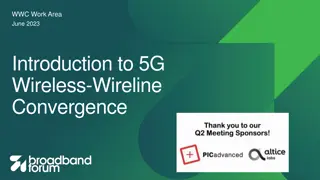
![Long-Range Wireless Charging Market Report & Analysis _ BIS Research [2024-2035]](/thumb/87166/long-range-wireless-charging-market-report-analysis-bis-research-2024-2035.jpg)
